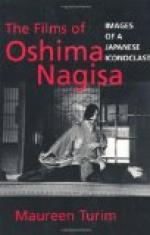|
This section contains 898 words (approx. 3 pages at 300 words per page) |

|
If we accept T. W. Adorno's assertion that the only choice open to a politically committed artist at this stage in history is to create a negative art, then Nagisa Oshima's The Ceremony must be considered a profoundly revolutionary work. Using as his metaphor a large, bourgeois family, Oshima seeks to analyze the nature of authoritarianism. On one level, the film can be seen as a study of this authoritarianism as manifest in the traditional Japanese family and, on another, as an exploration of the totality of postwar Japanese experience during the years 1946 to 1971.
One of the key aspects of traditional Japanese society is the fetishization of ritual; there is a set 'way' in which certain things are done, according to time-honored custom. Another is paternalism, which extends from veneration of the Emperor as father-figure to the whole nation to the recognition of the absolute supremacy of the...
|
This section contains 898 words (approx. 3 pages at 300 words per page) |

|


